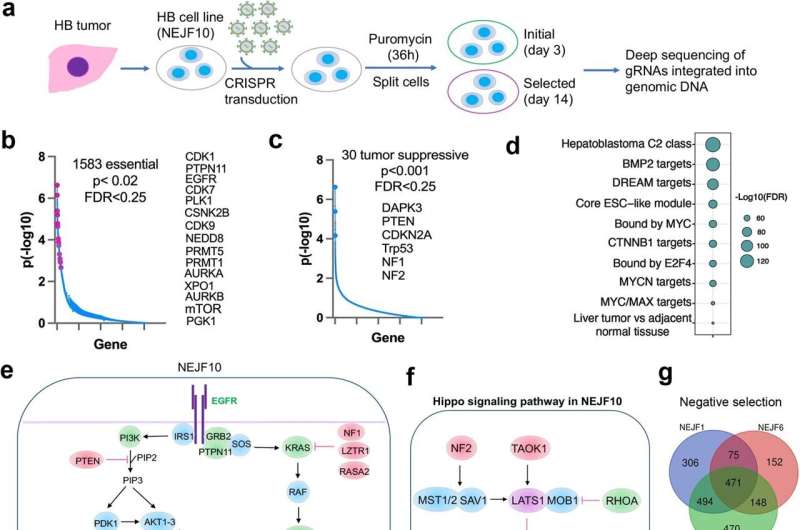This article has been reviewed according to Science X's editorial process and policies. Editors have highlighted the following attributes while ensuring the content's credibility:
fact-checked
peer-reviewed publication
trusted source
proofread
Pediatric hepatoblastoma model hints at DNA damage repair pathway for novel therapeutics

Scientists at St. Jude Children's Research Hospital created a hepatoblastoma (liver cancer) model that more accurately reflects the pathology and genomics of the disease. Research using the model pointed toward potential pathways to improve therapies, including DNA damage repair pathways which are well-known for their involvement in other types of cancer.
Hepatoblastoma is a type of liver cancer that most often affects children younger than three. This cancer has seen the largest incidence increase of all pediatric cancers worldwide. For high-risk patients, which account for up to 20% of cases, the chances of an event-free survival are less than 50% underscoring the tremendous need for new therapies.
"These patients are routinely treated with chemotherapy for high-risk disease, but—especially when talking about hepatoblastoma in children who are still developing—the long-term effects can be a big concern," said corresponding author Jun Yang, Ph.D., St. Jude Department of Surgery.
A key step to improving cancer treatment is to ensure that a robust, easily accessible model for research exists. This model usually is a group of lab-grown cells called a cell line that replicates characteristics of the cancer and can be easily regrown and transported, allowing researchers around the world to study how the cancer develops and responds to therapies.
The ability to conduct meaningful cancer research is directly related to the availability of these cell lines; this has been severely lacking for some cancers. The St. Jude–led team turned to next-generation sequencing technologies to gain insight into the genomics of hepatoblastoma to create a more accurate model.
Next-generation techniques characterize tumors
Recognizing that an improved cell line could lead to breakthroughs that improve patient treatment, the researchers set out to find genetic mutations that drive hepatoblastoma. The MYC family of proteins, which function in transcription, are dysregulated in most human cancers, including hepatoblastoma. Researchers mutated the MYC gene in a mouse model and discovered that it quickly and reliably drove hepatoblastoma formation. Full characterization was now needed to validate their work.
Hepatoblastoma is known to have a high level of transcriptional heterogeneity, meaning cells within a tumor express genes at different levels and at different times. This may suggest they respond to therapy differently too. The availability of single-cell RNA sequencing techniques and spatial transcriptomics allowed the researchers to characterize the model tumors thoroughly and ensure their conformity with patient-derived tumors.
"These techniques allow us to view normal tissue and tumor cells in the context of their local environment, offering a high-resolution peek at both the tumor transcriptional heterogeneity as well as the different 'neighborhoods' within a tumor," said co-corresponding author Xiang Chen, Ph.D., St. Jude Department of Computational Biology. "Our model recapitulates a high degree of tumor heterogeneity which mimics the level of heterogeneities observed in patient tumors," he explained.
DNA damage repair pathway offers novel therapeutic routes for hepatoblastoma
With the cell line established, the researchers explored what a new therapeutic might look like to treat hepatoblastoma. They performed a genome-wide CRISPR-Cas9 screen to identify essential genes required for tumor cell survival. Over 1,500 genes were identified as potential targets, with 100 of these having pre-existing inhibitors available. Yang describes this as a massive coup for the field:
"This means we can find many targets to test. Any researchers with a shared interest can use our detailed screening information to verify their hypotheses and develop new therapies," he said.
Along with identifying new targets, the researchers wanted to see which genes were affected by conventional chemotherapies used to treat hepatoblastoma, primarily doxorubicin. Doxorubicin blocks an enzyme responsible for tumor cell growth and division, and by looking at the genetic responses of hepatoblastoma cells when it is administered to a patient, the researchers hoped to identify how to increase its therapeutic effect and offer safer, more effective treatment. The protein PRKDC was identified as one such target, and when used in combination with doxorubicin, PRKDC inhibition enhanced treatment efficacy.
PRKDC is a protein involved in DNA damage repair. The hypothesis proposed by the researchers is that by inhibiting the function of PRKDC, DNA damage is worsened within tumor cells, and a synergistic effect takes place where the effect of doxorubicin is amplified, thereby killing the tumor.
This work offers much-needed insight into an often-overlooked cancer which will significantly improve the outlook for future patients.
The study is published in the journal Nature Communications.
More information: Jie Fang et al, Genome-wide mapping of cancer dependency genes and genetic modifiers of chemotherapy in high-risk hepatoblastoma, Nature Communications (2023). DOI: 10.1038/s41467-023-39717-6



















